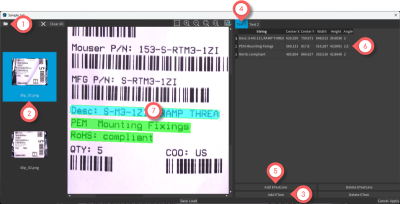The class ESampleList contains all the information about a "customer use case".
|
□
|
You can specify a ERegion inside an ESample corresponding to the region used to read the image with ETextReader.Read. It is particularly useful if the region where the "text of interest" lies is found by some pre-processing. |
The best way to create an ESampleList is through a graphic interface because you need to annotate the "texts of interest". The new Open eVision Studio provides a widget to perform this annotation painlessly. Nevertheless, you can also create the ESampleList using the API.
new Open eVision Studio widget
The new Open eVision Studio widget for the edition of an ESampleList
To manage your ESampleList:
|
1.
|
Open a file explorer to add one or several images to the batch. |
|
►
|
An ESample is created for each image added to the batch. |
|
2.
|
Display the list of the ESample. The ESample currently selected is highlighted. |
|
4.
|
Display the list of EText for the selected ESample. The EText currently selected is highlighted. |
|
□
|
You must edit the string of the ETextLine from this table. |
|
□
|
You can edit the position of the ETextLine from this table. |
|
□
|
You can edit the position of the ETextLine using the handles. |
|
□
|
The orientation of the ETextLine is indicated by a small arrow. |
The public API
The creation of the ESampleList using the public API is illustrated in the code snippet below.
You can easily modify this code snippet to include more ESample, EText and ETextLine.
EasyDeepOCR expects that the rectangle of the ETextLine is tightly adjusted to the texts. There must be no margin between the text line and the border of the rectangle.
#include <Open_eVision.h>
void BuildingASampleList()
{
////////////////////////////////////////////////////////
// This code snippet shows how to fill a sample list. //
////////////////////////////////////////////////////////
using namespace Euresys::Open_eVision;
namespace EDO = Euresys::Open_eVision::EasyDeepOCR;
// Create an ESampleList
EDO::ESampleList sampleList;
// Create an ESample vector
std::vector<EDO::ESample> samples(1);
// Fill the ESample vector
for (EDO::ESample& sample : samples)
{
// Set the image
sample.SetImagePath("image.tif");
// Create an EText vector
std::vector<EDO::EText> texts(1);
// Fill the EText vector
for (EDO::EText& text : texts)
{
// Create an ETextLine vector
std::vector<EDO::ETextLine> textLines(1);
// Fill the ETextLine vector
for (EDO::ETextLine& textLine : textLines)
{
// Adjust the ERectangle around the text line
textLine.SetRectangle(ERectangle());
// Annotate the text line
textLine.SetString("");
}
// Set the ETextLine vector
text.SetLines(textLines);
}
// Set the EText vector
sample.SetTexts(texts);
}
// Set the ESample vector
sampleList.SetSamples(samples);
// ...
}
using Euresys.Open_eVision;
using EDO = Euresys.Open_eVision.EasyDeepOCR;
static partial class Snippet
{
static void BuildingASampleList()
{
////////////////////////////////////////////////////////
// This code snippet shows how to fill a sample list. //
////////////////////////////////////////////////////////
// Create an ESampleList
EDO.ESampleList sampleList = new EDO.ESampleList();
// Create an ESample vector
EDO.ESample[] samples = new EDO.ESample[1];
// Fill the ESample vector
foreach (EDO.ESample sample in samples)
{
// Set the image
sample.ImagePath = "image.tif";
// Create an EText vector
EDO.EText[] texts = new EDO.EText[1];
// Fill the EText vector
foreach (EDO.EText text in texts)
{
// Create an ETextLine vector
EDO.ETextLine[] textLines = new EDO.ETextLine[1];
// Fill the ETextLine vector
foreach (EDO.ETextLine textLine in textLines)
{
// Adjust the ERectangle around the text line
textLine.Rectangle = new ERectangle();
// Annotate the text line
textLine.String = "";
}
// Set the ETextLine vector
text.Lines = textLines;
}
// Set the EText vector
sample.Texts = texts;
}
// Set the ESample vector
sampleList.Samples = samples;
// ...
}
}
def BuildingASampleList():
#########################################################
## This code snippet shows how to fill a sample list. ##
#########################################################
import open_evision as oev
from open_evision import EasyDeepOCR as EDO
# Create an ESampleList
sampleList = EDO.ESampleList()
# Create an ESample vector
samples = [EDO.ESample()]
# Fill the ESample vector
for sample in samples:
# Set the image
sample.ImagePath = "image.tif"
# Create an EText vector
texts = [EDO.EText()]
# Fill the EText vector
for text in texts:
# Create an ETextLine vector
textLines = [EDO.ETextLine()]
# Fill the ETextLine vector
for textLine in textLines:
# Adjust the ERectangle around the text line
textLine.Rectangle = oev.ERectangle()
# Annotate the text line
textLine.String = ""
# Set the ETextLine vector
text.Lines = textLines
# Set the EText vector
sample.Texts = texts
# Set the ESample vector
sampleList.Samples = samples
# ...
